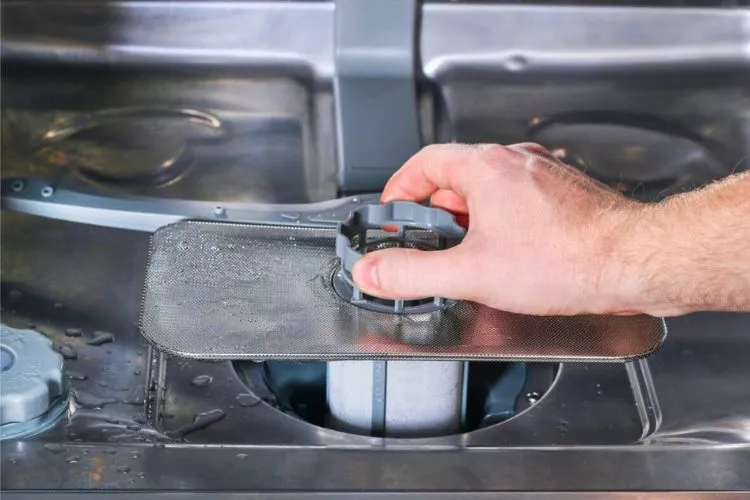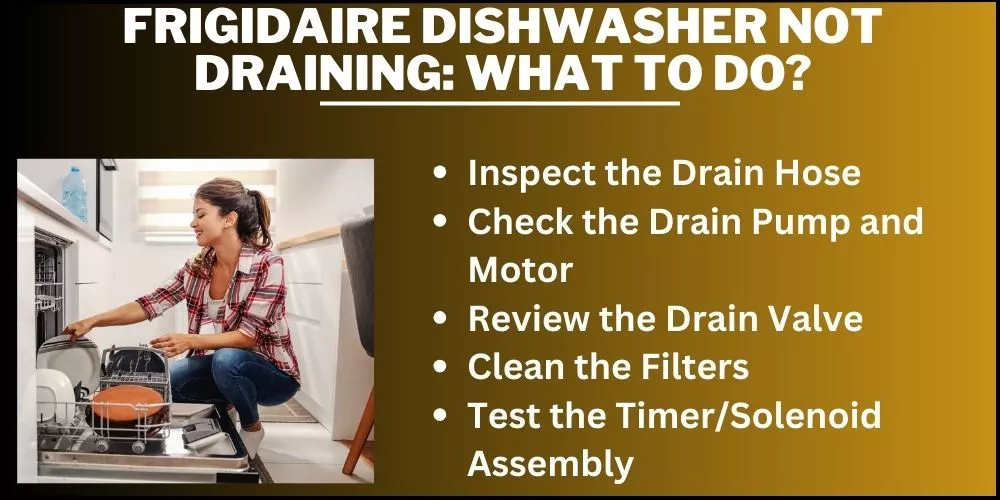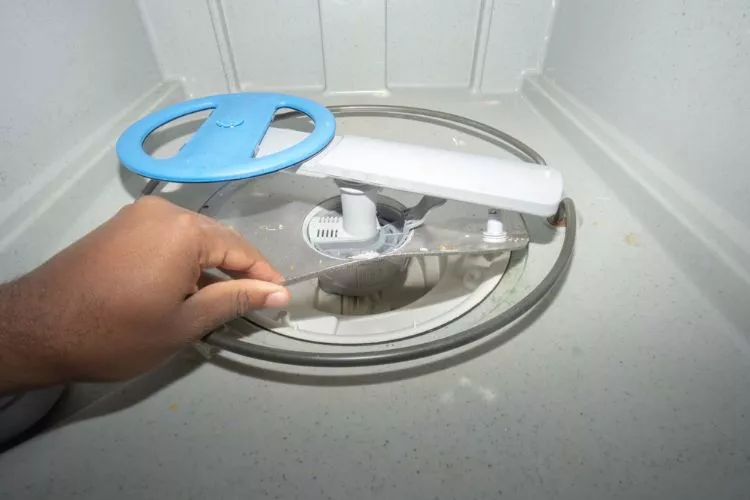Is your Frigidaire dishwasher not draining as expected? Persistent water at the base of your machine can be an alarming sight and may pose potential malfunctions.
This article explores the complexities of this unexpectedly common issue.
Discover possible reasons and solutions to resolve your Frigidaire dishwasher’s drainage problem, from a simple clog to more technical difficulties, backed by expert guidance.

By the end, we hope to equip you with the understanding and steps needed to ensure your dishwasher gets back to peak performance!
Frigidaire dishwasher not draining: what to do?
If these below mentioned detailed steps leave you with a still clogged dishwasher, it might be time to seek professional help. Remember, working with electrical appliances always poses a potential hazard, so when in doubt, consult with an expert!

1. Inspect the Drain Hose
Clogs often occur in the drain hose. Follow these steps to check for blockages:
- Step 1: Disconnect the dishwasher from power.
- Step 2: Locate the drain hose (usually connected to the drain pump underneath the dishwasher).
- Step 3: Disconnect the hose and check for blockages. If necessary, clean it out with a straightened wire coat hanger or a plumber’s snake.
2. Check the Drain Pump and Motor
A defective pump or motor can prevent your dishwasher from draining properly. Here’s how to inspect it:
- Step 1: As always, safety first! Disconnect the dishwasher from the power source.
- Step 2: Refer to your model’s manual to locate the pump and motor. Generally, they are found at the bottom of the dishwasher and can be accessed by removing the lower rack and spray arm.
- Step 3: Once located, inspect the pump for cracks, damage, or any foreign objects that may obstruct the motor’s fan blades. Sometimes accumulated food debris can prevent proper draining. If you spot any blockages, clean them away gently using a soft brush. Also, spin the motor shaft to ensure it’s spinning freely.
3. Review the Drain Valve
Sometimes, a faulty drain valve can be the root of the problem:
- Step 1: After disconnecting the power, locate the drain valve. It’s generally found attached to the motor and pump assembly.
- Step 2: The drain valve uses a solenoid to operate. Verify that this solenoid is functioning correctly. Listen for a click when power is supplied, indicating proper operation.
- Step 3: Check for obstructions or signs of wear that could prevent the valve from opening. Food or other particles might become lodged, preventing the valve from fully opening and affecting drainage.
4. Clean the Filters
Clogged or dirty filters are other common culprits behind slow or stopped drainage:
- Step 1: Locate the filters. These are typically positioned at the bottom of the dishwasher, under the lower sprayer.
- Step 2: Remove the filters gently to prevent damage. Rinse them under a tap with warm water. Use a soft brush (an old toothbrush is ideal) to scrub away any stubborn debris without damaging the filter.
- Step 3: When the filters are clean and dry, replace them by positioning them correctly in their dedicated places. Make sure they fit snugly to prevent food particles from clogging up the drain.
5. Test the Timer/Solenoid Assembly
The timer/solenoid assembly is responsible for managing the dishwasher’s various cycles, including draining. If it malfunctions, the dishwasher may not drain efficiently. Here’s how to troubleshoot it:
- Step 1: Ensure the dishwasher is disconnected from the power source to avoid any electrical hazards.
- Step 2: Locate the timer/solenoid assembly; this can typically be found behind the control panel. Consult your dishwasher’s manual for specific instructions.
- Step 3: Inspect the wiring connections to ensure they’re secure and undamaged. If the connections are loose or frayed, they might need tightening or replacement to restore proper functioning.
- Step 4: Visually examine the timer or control board for any signs of burning or wear, which could indicate a failure. Some models have test points you can use to confirm the timer’s proper functioning.
- Step 5: For dishwashers with a timer, turn the timer dial manually to check if it moves smoothly without getting stuck. If the timer seems to be functioning properly, focus on inspecting the solenoid.
- Step 6: Locate the drain solenoid, which is typically near the drain pump and motor assembly. Check for any visible signs of wear, damage, or broken springs. If you have a multimeter, use it to test the solenoid’s continuity and resistance levels. A solenoid showing no continuity or an incorrect resistance level might be faulty and require replacement.
Keep in mind, this is a technical and challenging process. If you’re unsure or uncomfortable while testing the timer/solenoid assembly, it’s best to consult with a professional appliance repair technician to help resolve the issue.
frigidaire dishwasher not draining at end of cycle
If your Frigidaire dishwasher isn’t draining at the end of the cycle, there are several potential causes and corresponding solutions you can explore.

- Drain Hose: Clogs in the drain hose are a common reason for your dishwasher not draining. Checking this first could save significant time. If your hose is clogged, try to remove the clog or if it is kinked, straighten it out and run the dishwasher again.
- Drain Pump: Another common cause is a blocked drain pump. To address this, remove the pump cover and inspect the pump for any obstructions.
- Failed components: More complex issues could be a result of failed components, such as a bad drain pump, a defective control board, or a broken timer.
- Clogged components: Other frequent culprits can be a clogged garbage disposal or debris in the drain basket.
In some cases, dishwashers seem to function normally, and the water from the last cycle still remains in after it has stopped. If you find the issue is complex or steps to repair these parts are not working, it could be time to consult with an expert technician or contact Frigidaire’s support.
Also, remember to go through the user manual for your specific dishwasher model. This manual should have more information on where parts are located and how to access them, along with some troubleshooting advice specific to your model.
frigidaire dishwasher not draining garbage disposal
If your Frigidaire dishwasher isn’t draining and you have a recently installed garbage disposal or it has not been used for a while, this might be the problem. The dishwasher usually drains into the garbage disposal, and a clog or installation issue can prevent proper drainage.
Here’s how you can troubleshoot this:

1. Check the Garbage Disposal Plug
- Step 1: Disconnect your garbage disposal from the power source.
- Step 2: Inspect the garbage disposal. Dishwashers drain into the garbage disposal, and a new disposal comes with a drain plug that needs to be removed if you plan to connect a dishwasher. If your disposal is new and the dishwasher was draining properly before, this could be the issue.
- Step 3: To remove the plug, insert a screwdriver into the dishwasher’s drain hose outlet on the disposal, then tap the screwdriver with a hammer. The plug should pop out. NOTE: Only do this if you’re sure the dishwasher is supposed to drain into the disposal.
2. Run the Garbage Disposal
Running your garbage disposal can often help clear out any blockages or food buildup that may be causing drainage issues for your dishwasher.
CAUTION: Remember to use plenty of cold water when running the garbage disposal.
If challenges persist after performing these tasks, it might be time to seek the assistance of a professional plumber or disposal/dishwasher technician to investigate the issue further.
Conclusion:
A Frigidaire dishwasher failing to drain could be due to several issues, from a clogged sink or dishwasher to faulty components such as the drain pump or drain valve.
While simple troubleshooting may resolve the issue in some cases, it’s essential to understand when to call a professional.
Regular inspection and maintenance can help avoid these problems, ensuring your Frigidaire dishwasher serves you efficiently for many years.
Your dishwasher is an investment in both convenience and time; thus, understanding its operation and maintenance is paramount.


